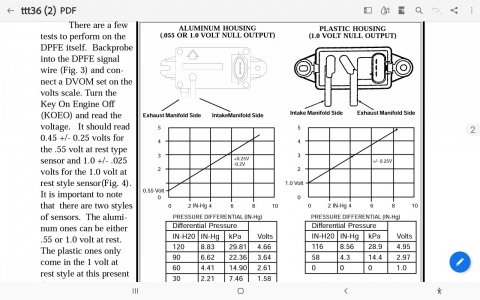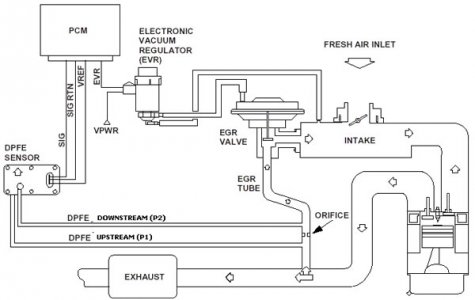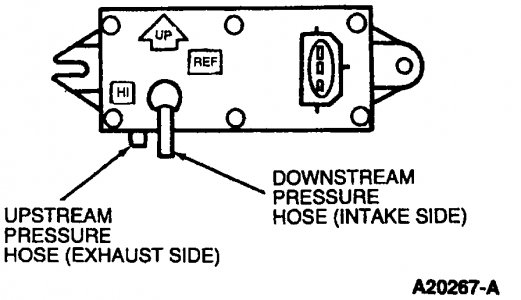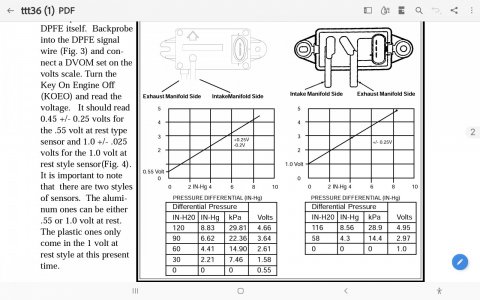Evening folks. i have an 86 b2 with a 95 explorer 4.0. i getting a code 33 on the obd1. this should be a egr valve. but i noticed the dpfe sensonsor only has one hose connected to it from the exhaust line that feeds the egr valve.havent had the vehicle too long.if anyone has the same setup and can verify that there should be to rubber lines going to it to sense pressure differntial from the exhaust line that feeds the egr.thanks
You are using an out of date browser. It may not display this or other websites correctly.
You should upgrade or use an alternative browser.
You should upgrade or use an alternative browser.
DPFE sensor
- Thread starter adrian p
- Start date
Disclaimer: Links on this page pointing to Amazon, eBay and other sites may include affiliate code. If you click them and make a purchase, we may earn a small commission.
Yo Adrian,
I have a 96 Bronco with the DPFE. Here is where some info that I have saved that applies to my 96;
DPFE Testing & Vacuum/Voltage Parameters & pics on both older Aluminum & Newer Plastic Version
Source: by tomco-inc.co
EXCERPT;
see attachment
DTC 33 & 34 "...DTC 33 is triggered when the EVP sensor is not closing.... To prevent the EGR valve from opening when the engine is cold, the vacuum line to the EGR valve may be connected to a parted vacuum switch or a computer-controlled solenoid. Vacuum is not allowed to pass to the valve until the engine is warm. EGR isn't needed when the engine is cold, only when it is warm and under load. Any of these codes could indicate a faulty EGR valve as well. as well as a problem in the ...vacuum solenoids' Miesk5 note; TAB & TAD; so repair those vac lines 1st..."
Source: by Larry C at aa1car
DTC 33, 332 EGR valve opening not detected; "...When performing computer Self-Test after installing this kit it is normal to get code...The computer is acknowledging that the EGR is permanently closed. This is your desired result. However if you get the following codes: 31 / 327 - EVP circuit failed below the closed EGR limit of 0.24 volts, 32 / 328 - EVP circuit failed below the closed EGR limit of 0.24 volts, 34 / 334 - EVP circuit failed above the closed EGR limit of 0.67 volts, 35 / 337 - EVP circuit failed above the open EGR limit of 4.81 volts; Check your connection again; make sure there is no resistance in the harness;..." in Eliminator Installation Manual
Source: by Ryan M (Fireguy50) at fordfuelinjection.com
I used DPFE HOSES; 1L3Z-9P761-AA - 1/4" for REF - Downstream hose (INTAKE)
DPFE HOSES; 1L3Z-9P761-BA - 5/16" for Upstream hose (EXHAUST)
Both are high-temp silicon
I have a 96 Bronco with the DPFE. Here is where some info that I have saved that applies to my 96;
DPFE Testing & Vacuum/Voltage Parameters & pics on both older Aluminum & Newer Plastic Version
Source: by tomco-inc.co
EXCERPT;
see attachment

DTC 33 & 34 "...DTC 33 is triggered when the EVP sensor is not closing.... To prevent the EGR valve from opening when the engine is cold, the vacuum line to the EGR valve may be connected to a parted vacuum switch or a computer-controlled solenoid. Vacuum is not allowed to pass to the valve until the engine is warm. EGR isn't needed when the engine is cold, only when it is warm and under load. Any of these codes could indicate a faulty EGR valve as well. as well as a problem in the ...vacuum solenoids' Miesk5 note; TAB & TAD; so repair those vac lines 1st..."
Source: by Larry C at aa1car
DTC 33, 332 EGR valve opening not detected; "...When performing computer Self-Test after installing this kit it is normal to get code...The computer is acknowledging that the EGR is permanently closed. This is your desired result. However if you get the following codes: 31 / 327 - EVP circuit failed below the closed EGR limit of 0.24 volts, 32 / 328 - EVP circuit failed below the closed EGR limit of 0.24 volts, 34 / 334 - EVP circuit failed above the closed EGR limit of 0.67 volts, 35 / 337 - EVP circuit failed above the open EGR limit of 4.81 volts; Check your connection again; make sure there is no resistance in the harness;..." in Eliminator Installation Manual
Source: by Ryan M (Fireguy50) at fordfuelinjection.com
I used DPFE HOSES; 1L3Z-9P761-AA - 1/4" for REF - Downstream hose (INTAKE)
DPFE HOSES; 1L3Z-9P761-BA - 5/16" for Upstream hose (EXHAUST)
Both are high-temp silicon
Attachments
Last edited:
Adrian,
Part 2
"...Ford EGR systems "...PCM will not operate the EGR valve unless it sees: The engine warmed up to normal operating temperature. TPS at partial throttle. TPS not at Wide Open Throttle (WOT). MAP/MAF must be indicating light or moderate load. A certain amount of computer clock time has to be elapsed..."
Differential Pressure Feedback (DPFE) TSB 97-22-1 (Bronco not Listed); miesk5 Note; test info & diagrams/depictions are correct for Bronco as well
note that this TSB applies to FORD: 1994-1997 MUSTANG, THUNDERBIRD 1995-1997 CONTOUR, CROWN VICTORIA 1996-1997 ******, TAURUS 1994-1997 EXPLORER 1995-1997 ECONOLINE, F-150-350 SERIES, WINDSTAR 1996-1997 AEROSTAR 1997 EXPEDITION LINCOLN: 1990-1997 TOWN CAR 1995-1997 CONTINENTAL 1998 NAVIGATOR MERCURY: 1994-1997 COUGAR 1995-1997 GRAND MARQUIS, MYSTIQUE 1996-1997 SABLE, TRACER 1997 MOUNTAINEER
Source: by Ford via stangnet.com
●
Part 2
"...Ford EGR systems "...PCM will not operate the EGR valve unless it sees: The engine warmed up to normal operating temperature. TPS at partial throttle. TPS not at Wide Open Throttle (WOT). MAP/MAF must be indicating light or moderate load. A certain amount of computer clock time has to be elapsed..."
Differential Pressure Feedback (DPFE) TSB 97-22-1 (Bronco not Listed); miesk5 Note; test info & diagrams/depictions are correct for Bronco as well
note that this TSB applies to FORD: 1994-1997 MUSTANG, THUNDERBIRD 1995-1997 CONTOUR, CROWN VICTORIA 1996-1997 ******, TAURUS 1994-1997 EXPLORER 1995-1997 ECONOLINE, F-150-350 SERIES, WINDSTAR 1996-1997 AEROSTAR 1997 EXPEDITION LINCOLN: 1990-1997 TOWN CAR 1995-1997 CONTINENTAL 1998 NAVIGATOR MERCURY: 1994-1997 COUGAR 1995-1997 GRAND MARQUIS, MYSTIQUE 1996-1997 SABLE, TRACER 1997 MOUNTAINEER
Source: by Ford via stangnet.com
●
Exhaust Gas Recirculation (EGR) SystemThe purpose of the Exhaust Gas Recirculation (EGR) system on your engine is to limit oxides of nitrogen (NOx) emissions. This is done by redirecting small amounts of exhaust gas back through the upper intake to get mixed in with the air/fuel charge. The resultant diluted air/fuel mixture (i.e., less oxygen per cubic foot) burns cooler and combustion chamber temperatures are reduced accordingly, thereby lowering NOx emissions.The Ford DPFE/EGR SystemThe Ford DPFE/EGR system is controlled by the Powertrain Control Module (PCM). The system employs an EGR Valve, an Electronic Vacuum Regulator (EVR), and a Delta Pressure Feedback EGR sensor (DPFE). - The EGR valve is mounted on (or very close) to the upper intake and is connected to both the intake and the exhaust system by virtue of a special EGR Tube. The valve has a vacuum port that allows it to be controlled (opened and closed) by the EVR. When the valve is open, exhaust gas flows into the upper intake and mixes with the a/f charge. - The DPFE Sensor measures EGR flow across an orifice located inside the special EGR Tube. The orifice is positioned between two hose ports coming off the tube which are connected to the DPFE sensor with special heat-resistant hoses. When the EGR Valve is open, a pressure differential is created across the orifice (intake manifold pressure vs. exhaust pressure). By design, this difference in pressure is measured by the DPFE sensor in terms of voltage. The DPFE voltage signal output to the PCM is directly proportional to the flow of exhaust gas entering the intake manifold. The PCM determines optimal conditions for EGR flow and then, based on the DPFE voltage signal and some other sensor data, activates the EVR to open and close the EGR valve as necessary. - The EVR is a solenoid with two vacuum ports. One port is connected to a vacuum source/supply, and the other is connected to the EGR valve. There is also a passage that vents vacuum to the atmosphere. A disc inside the solenoid is moved by electro-magnetic force, as directed by the PCM. If more EGR flow is required, the PCM increases the duty-cycle to the EVR, moving the disc to close off the atmospheric vent, which in turn increases the amount of vacuum flow to the EGR valve. If less EGR flow is desired, the PCM decreases the duty-cycle to the EVR, allowing for more atmospheric venting and hence less vacuum flow to the EGR valve. The EVR is a "normally closed" solenoid, which means that when it is de-energized, the position of the disc allows for maximum venting to the atmosphere (resulting in negligible vacuum flow to the EGR valve). Note that Ford EGR systems DO NOT engage when: 1) The engine is cold ; 2 ) The engine is at idle; 3 ) The engine is at WOT; 4) At low ambient temps (water vapor from the exhaust can freeze on the throttle plate). ● |
Adrian,
Part 3
Overview & Parts Break-Out Diagram; "...The Exhaust Gas Recirculation (EGR) System is designed to reintroduce exhaust gas into the combustion cycle lowering combustion temperatures and reducing the formation of Nitrous Oxide. There are two basic types of EGR systems: The PFE/DPFE System (9J460 9D475) & The EVP System 9F483 (9H473 9G428 ). Trucks never used a Pressure Feedback Exhaust (PFE) Sensor. The amount of exhaust gas reintroduced and the timing of the cycle varies by calibration and is controlled by factors such as engine speed, engine vacuum, exhaust system back pressure, coolant temperature and throttle angle. All EGR valves are vacuum actuated. The vacuum diagram is shown on the emission decal for each calibration. Pressure Feedback EGR (PFE/DPFE) Systems FE is a subsonic closed loop EGR system that controls EGR flow rate by monitoring the pressure drop across a remotely located sharp-edged orifice. The system uses a pressure transducer (9J460) as the feedback device and controlled pressure is varied by valve modulation using vacuum output of the EGR Vacuum Regulator (EVR) solenoid (9J459). With a PFE system, the EGR valve only serves as a pressure regulator rather than a flow metering device. The Differential Pressure Feedback EGR (DPFE) system operates in the same manner except it directly monitors the pressure drop across the metering orifice. This allows for a more accurate assessment of EGR flow requirements. The EVP EGR Valve is required in EEC systems where EGR flow is controlled by the Powertrain Control Module (PCM) through an EGR Valve Position (EVP) sensor attached to the valve. The EVP sensor provides the EEC system with a signal indicating position of the EGR valve. The valve is operated by a vacuum signal from the EGR Vacuum Regulator (EVR) Solenoid (9J459) which actuates the valve diaphragm. As supply vacuum overcomes the spring load, the diaphragm is actuated. This lifts the pintle off its seat allowing exhaust gas to recirculate (flow). The amount of flow is proportional to the pintle position. The EVP sensor mounted on the valve sends an electrical signal of its position to the PCM (12A650)..." Note, Trucks never used a Pressure Feedback Exhaust (PFE) Sensor; READ MUCH MORE
FE is a subsonic closed loop EGR system that controls EGR flow rate by monitoring the pressure drop across a remotely located sharp-edged orifice. The system uses a pressure transducer (9J460) as the feedback device and controlled pressure is varied by valve modulation using vacuum output of the EGR Vacuum Regulator (EVR) solenoid (9J459). With a PFE system, the EGR valve only serves as a pressure regulator rather than a flow metering device. The Differential Pressure Feedback EGR (DPFE) system operates in the same manner except it directly monitors the pressure drop across the metering orifice. This allows for a more accurate assessment of EGR flow requirements. The EVP EGR Valve is required in EEC systems where EGR flow is controlled by the Powertrain Control Module (PCM) through an EGR Valve Position (EVP) sensor attached to the valve. The EVP sensor provides the EEC system with a signal indicating position of the EGR valve. The valve is operated by a vacuum signal from the EGR Vacuum Regulator (EVR) Solenoid (9J459) which actuates the valve diaphragm. As supply vacuum overcomes the spring load, the diaphragm is actuated. This lifts the pintle off its seat allowing exhaust gas to recirculate (flow). The amount of flow is proportional to the pintle position. The EVP sensor mounted on the valve sends an electrical signal of its position to the PCM (12A650)..." Note, Trucks never used a Pressure Feedback Exhaust (PFE) Sensor; READ MUCH MORE
Source: by Steve83
●
Depiction,Overview, Construction, & Voltages, Older Aluminum Version; "...DPFE SIG is This voltage at idle is approximately 0.45 volts; SIG RET is GROUND; V REF is 5 volt reference. DTC PO1400, P1401, PO402, P1403, P1408; "There are a number of tests that the EGR system is put through. First the DPFE is checked. It is continuously monitored for opens or shorts. The OBD II system looks for the DPFE signal to exceed the minimum or maximum values. If it finds these values out of specs a DTC P01400 or 1401 will be set The OBD II system also monitors the EGR flow rate. At a steady state condition when the engine load and speed are moderate and the EVR duty cycle is high the DPFE voltage is checked. It then compares this DPFE value to a stored desired DPFE value for those conditions. If the two values are inconsistent, the EGR flow is insufficient (Fig. 11). A DTC P0401 will be set for this condition. This test is also performed during a Key On Engine Running (KOER) test. If it fails during this test a DTC 1408 will be set; The OBDII system monitors continuosuly the DPFE signal at idle. Since there should be no EGR flow at idle, the DPFE signal should show a no flow voltage signal. The system compares the Key On Engine Off (KOEO) stored voltage to the DPFE signal at idle. If the signal is not consistent with this value, it may indicate a stuck open EGR valve. The DTC for this condition is a P0402. The EVR is continuously tested for opens or shorts. The OBDII system looks for a circuit voltage that is out of range or inconsistent with the EVR commanded output state. If it finds a fault in the EVR circuit voltage a DTC P1409 will be set. There are a number of tests that the EGR system is put through. First the DPFE is checked. It is continuously monitored for opens or shorts. The OBD II system looks for the DPFE signal to exceed the minimum or maximum values. If it finds these values out of specs a DTC P01400 or 1401 will be set. The system then looks for a DPFE voltage value that is inconsistent with a no flow situation. If the DPFE voltage increases or decreases this may indicate a fault with the upstream hose. A DTC P1405 will be set for this condition. A DTC P1406 will be set if there is a problem with the downstream hose. The OBD II system also monitors the EGR flow rate. At a steady state condition when the engine load and speed are moderate and the EVR duty cycle is high the DPFE voltage is checked. It then compares this DPFE value to a stored desired DPFE value for those conditions. If the two values are inconsistent, the EGR flow is insufficient (Fig. 11). A DTC P0401 will be set for this condition. This test is also performed during a Key On Engine Running (KOER) test. If it fails during this test a DTC 1408 will be set. The OBD II system also checks the DPFE signal when the EGR valve is open for a negative voltage. If a negative voltage is detected the hoses may be reversed. If it fails this test a DTC 1403 will be set. The EVR is continuously tested for opens or shorts. The OBDII system looks for a circuit voltage that is out of range or inconsistent with the EVR commanded output state. If it finds a fault in the EVR circuit voltage a DTC P1409 will be set..." READ MORE
Source: by tomco-inc.com
●
Part 3
Overview & Parts Break-Out Diagram; "...The Exhaust Gas Recirculation (EGR) System is designed to reintroduce exhaust gas into the combustion cycle lowering combustion temperatures and reducing the formation of Nitrous Oxide. There are two basic types of EGR systems: The PFE/DPFE System (9J460 9D475) & The EVP System 9F483 (9H473 9G428 ). Trucks never used a Pressure Feedback Exhaust (PFE) Sensor. The amount of exhaust gas reintroduced and the timing of the cycle varies by calibration and is controlled by factors such as engine speed, engine vacuum, exhaust system back pressure, coolant temperature and throttle angle. All EGR valves are vacuum actuated. The vacuum diagram is shown on the emission decal for each calibration. Pressure Feedback EGR (PFE/DPFE) Systems
Source: by Steve83
●
Depiction,Overview, Construction, & Voltages, Older Aluminum Version; "...DPFE SIG is This voltage at idle is approximately 0.45 volts; SIG RET is GROUND; V REF is 5 volt reference. DTC PO1400, P1401, PO402, P1403, P1408; "There are a number of tests that the EGR system is put through. First the DPFE is checked. It is continuously monitored for opens or shorts. The OBD II system looks for the DPFE signal to exceed the minimum or maximum values. If it finds these values out of specs a DTC P01400 or 1401 will be set The OBD II system also monitors the EGR flow rate. At a steady state condition when the engine load and speed are moderate and the EVR duty cycle is high the DPFE voltage is checked. It then compares this DPFE value to a stored desired DPFE value for those conditions. If the two values are inconsistent, the EGR flow is insufficient (Fig. 11). A DTC P0401 will be set for this condition. This test is also performed during a Key On Engine Running (KOER) test. If it fails during this test a DTC 1408 will be set; The OBDII system monitors continuosuly the DPFE signal at idle. Since there should be no EGR flow at idle, the DPFE signal should show a no flow voltage signal. The system compares the Key On Engine Off (KOEO) stored voltage to the DPFE signal at idle. If the signal is not consistent with this value, it may indicate a stuck open EGR valve. The DTC for this condition is a P0402. The EVR is continuously tested for opens or shorts. The OBDII system looks for a circuit voltage that is out of range or inconsistent with the EVR commanded output state. If it finds a fault in the EVR circuit voltage a DTC P1409 will be set. There are a number of tests that the EGR system is put through. First the DPFE is checked. It is continuously monitored for opens or shorts. The OBD II system looks for the DPFE signal to exceed the minimum or maximum values. If it finds these values out of specs a DTC P01400 or 1401 will be set. The system then looks for a DPFE voltage value that is inconsistent with a no flow situation. If the DPFE voltage increases or decreases this may indicate a fault with the upstream hose. A DTC P1405 will be set for this condition. A DTC P1406 will be set if there is a problem with the downstream hose. The OBD II system also monitors the EGR flow rate. At a steady state condition when the engine load and speed are moderate and the EVR duty cycle is high the DPFE voltage is checked. It then compares this DPFE value to a stored desired DPFE value for those conditions. If the two values are inconsistent, the EGR flow is insufficient (Fig. 11). A DTC P0401 will be set for this condition. This test is also performed during a Key On Engine Running (KOER) test. If it fails during this test a DTC 1408 will be set. The OBD II system also checks the DPFE signal when the EGR valve is open for a negative voltage. If a negative voltage is detected the hoses may be reversed. If it fails this test a DTC 1403 will be set. The EVR is continuously tested for opens or shorts. The OBDII system looks for a circuit voltage that is out of range or inconsistent with the EVR commanded output state. If it finds a fault in the EVR circuit voltage a DTC P1409 will be set..." READ MORE
Source: by tomco-inc.com
●
Motech
Well-known member
Wow, my brain is swimming.
Yes, there should be two hoses on DPFE.
And they are special, hi-temp silicone hoses. Fuel or vacuum hoses will last a couple-three tanks of fuel at best.
Yes, there should be two hoses on DPFE.
And they are special, hi-temp silicone hoses. Fuel or vacuum hoses will last a couple-three tanks of fuel at best.
Motech
Well-known member
From Ford:
1995 Ford Truck Explorer 4WD V6-245 4.0L
Differential Pressure Feedback EGR Sensor

Note the hose ports are two different sizes, which match the exhaust pipe sizes, so hookup match is straightforward.
PURPOSE
The Differential Pressure Feedback (DPFE) EGR sensor converts a varying exhaust pressure signal into a proportional analog voltage which is digitized by the Powertrain Control Module (PCM).
OPERATION
The PCM uses the signal received from the DPFE sensor to compute the optimum EGR flow.
1995 Ford Truck Explorer 4WD V6-245 4.0L
Differential Pressure Feedback EGR Sensor

Note the hose ports are two different sizes, which match the exhaust pipe sizes, so hookup match is straightforward.
PURPOSE
The Differential Pressure Feedback (DPFE) EGR sensor converts a varying exhaust pressure signal into a proportional analog voltage which is digitized by the Powertrain Control Module (PCM).
OPERATION
The PCM uses the signal received from the DPFE sensor to compute the optimum EGR flow.
L\Bronco
Well-known member
What you have on your 86 is PFE, its essentially DPFE's grandpa. A single hose connected to the egr system that looks for a change in pressure when the valve was commanded open. Very rudimentary and inaccurate. If no pressure change is sensed, a 33 sets. Can be anything from a plugged egr passage, to a stuck valve or vac line failure or EGRVR solenoid failure, or PFE sensor failure or a cracked hose to the sensor. Pretty much anything in there is suspect.Evening folks. i have an 86 b2 with a 95 explorer 4.0. i getting a code 33 on the obd1. this should be a egr valve. but i noticed the dpfe sensonsor only has one hose connected to it from the exhaust line that feeds the egr valve.havent had the vehicle too long.if anyone has the same setup and can verify that there should be to rubber lines going to it to sense pressure differntial from the exhaust line that feeds the egr.thanks
Hope that helps
Cheers
Motech
Well-known member
What you have on your 86 is PFE, its essentially DPFE's grandpa.
You might have missed this part bud.
...an 86 b2 with a 95 explorer 4.0...
L\Bronco
Well-known member
yep, oopsYou might have missed this part bud.
Similar threads
- Replies
- 11
- Views
- 3K
- Replies
- 1
- Views
- 840

